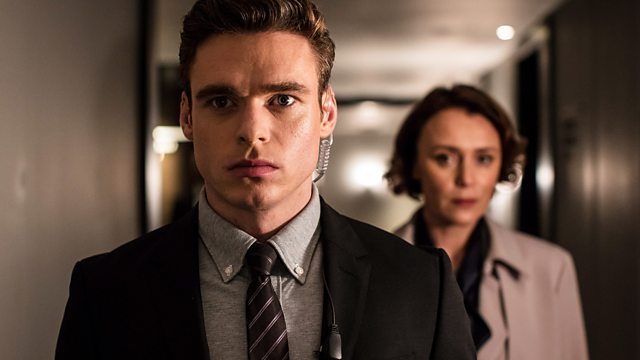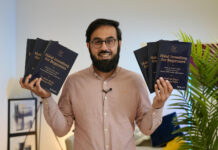Arzu Merali says that despite getting the nation well and truly hooked the BBC series The Bodyguard played into virtually every Islamophobic stereotype.
It’s Monday evening and I am still annoyed, and frankly alarmed. I am still thinking about the finale of the BBC Drama series Bodyguard that aired in the UK last night, precisely because it highlights how it just gets harder by the minute to be a Muslim represented or included in the national conversation.
I have written about the ten key narratives of Islamophobia in the UK, and alarmingly Bodyguard packs up and rolls quite a few into the very small space it made for the Muslim characters in the show. Out of ten it ticks the boxes of seven, with a particularly misogynistic gaze cast on its “Muslimah fatale,” Nadia:
- Muslims as disloyal and a threat to internal democracy
- Islam as a counter to “Britishness” / “Fundamental British Values”
- Muslims and “extremism”
- Muslims as a security threat (and therefore in need of regulation by way of exceptional law, policy and social praxis)
- Muslim misogyny and perversion and the oppressed Muslim woman
- Muslims as subhuman and unable to socialise to “human” norms
- Immigration and the demographic threat
This is despite the fact that the programme’s writer, Jed Mercurio, I believe honestly thought he was helping.
Warning signs
To write this, I have wrenched myself away from Twitter and the conversations calling out the disappointingly lazy ending to a drama that has convulsed the nation and which, arguably became a cultural phenomenon, engrossing the entire nation and getting viewing figures last heard of when there were only four or five terrestrial TV channels. That’s what makes what happened so relevant.
In summary, a story that promised and largely delivered big twists and turns, positing the ideas of major conspiracies of state, involving the Home Secretary and or the Secret Services and or the Police in particular SO15 (the notorious anti-terrorism squad) and maybe with a bit of organised crime thrown in, drew together the nation in endless conversations of not just who did but how.
Subscribe to our newsletter and stay updated on the latest news and updates from around the Muslim world!
Despite knowing it’s ersatz realism, I hoped this would be an exploration of the potentials and actuality of serious rights violations, and structural violence form the state against its citizens, whether veterans, Muslims or activists. All of it is set against the backdrop of the introduction of even more draconian laws as part of the anti-terror regime. When you do the type of work I do, it’s less ersatz and more real.
There were warning signs early on – I was panicked by the representation of peace activists, based very obviously on actual people and groups. The Riz Test, called out the portrayal of the character Nadiya, and failed the show early on its representation of Muslims. The writer, Jed Mercurio responded that we should wait until the end before making judgements. So we did. In the end: it was a bent copper, a radicalised ex-veteran and peace campaigner-unironically-turned-assassin (yes, you did read that right) and wait for it, an oppressed Muslim woman who turned out to be … drum roll please, not oppressed just your regular overeducated-Muslim-woman-engineer-terrorist, what did it.
According to Mercurio, he had upset the stereotype apple cart by making Nadia the master bomber and exploding (excuse the pun) the oppressed Muslim woman myth. Er, well not really. This isn’t the David Cameron “can’t speak English” Nadia, but the Michael Govian “Celsius 7/7” Nadia. You don’t need to fear Nadia not being able to speak English thus allowing her sons to be radicalised. She will do the job herself. Couldn’t she have just been a doctor? A scene shot in Central Middlesex Hospital which is located in the London Borough of Brent was strangely bereft of people of colour.
The uncontroversial demonisation of Muslims
More than anything I am hurt on a personal level having invested just over six hours watching it, and I don’t know how much longer discussing it, reading tweets about it, and getting dragged into this five week national pastime of choosing or creating any number of wild theories of whodunit (my personal favourite was the Romeo and Juliet theory, would that it had been so).
Instead I found out that I am not part of that conversation (again), and that however much I felt part of this silly conversation – a who dunnit on the scale of “Who Shot JR” (bear with us if you are under 40 years of age) – actually I was entirely left out.
I can hear well rehearsed responses of “it’s fiction.” Everyone understands that it was great drama, the actress playing Nadia had great facial expressions (wasn’t there another Nadiya, a real one, with great facial expressions too?). We should care because this incredible cultural moment that brought so many people together did so at the expense of those voices who needed to be included the most.
By that I don’t just mean Muslims who were scarce, bar bomb-making-lady Nadia. I think there were: suspected bomb-making hubby; suspected bomber parliamentary researcher; some dodgy e-fits but that’s it in a drama set on the streets, shops and hospitals of London.
I also mean a “Muslim’ politics. This is the demonisation of both Muslim participation in society in ways which are uncontroversial, e.g. as parliamentary researcher (in this show a suspected bomber who is forgotten rather than exonerated), or the missing doctors and nurses in the hospitals, but also a “Muslim” politics e.g. being against the wars in Afghanistan and Iraq as with Andy Apsted, a radicalised ex-veteran whose PTSD is used to explain his descent into political violence.
His leadership of a group ostensibly committed to peace is shown to be actually a cover for his violence now turned against the state he once fought for. Bung a hijab on him, we all know where this type of demonisation started. And that’s key. Because Islamophobia is not based on reality, just as any racism it works in its own illogic. Islamophobia is not just about Muslims but as with all racisms rises when there is a project or current of “nation” building in the old fashioned colonial sense of “one nation, one religion, one ethnicity.”
Where there is no unanimity, because, well there shouldn’t be, an idea of it can only be created by positing the idea to the so-called majority of being what they are not. In this case they are united by virtue of not being Muslim, and anything that shows Muslimness, be it dissident politics and or peace movements, it’s all “Jihadi” mate.
And this is rising all across Europe, cross-fertilising across borders and being internalised in parts of the Global South where Muslims are in minority and majority situations.
I do understand, really I do, that this was Jed Mercurio’s idea of empowering not demonising. Had we not been in an era of violent racisms reasserting, it may even have worked, but context is everything and this feels like it was done in a vacuum.
If by any chance he does get to read this, then please Jed, read this work on counter-narratives to Islamophobia. It talks about this issue in depth, and how even well-meaning attempts can go badly wrong.
Then there is of course The Riz Test, and the IHRC report from over ten years ago on just the same thing, and Jack Shaheen’s Reel Bad Arabs, and the list goes on. I know Mercurio has consulted extensively on issues of policing, now it’s time for more extensive consultation on Islam, Muslims and people of colour per se.
Maybe we can have a bit of redress in Line of Duty with a hijab wearing (uncorrupt) DI interviewing suspects of the same rank or lower!
This first article first appeared on the IHRC website.




















